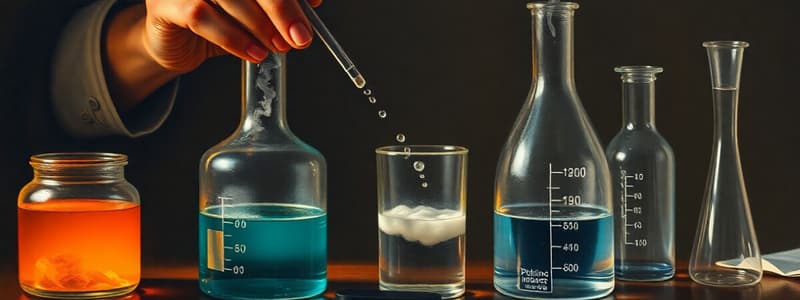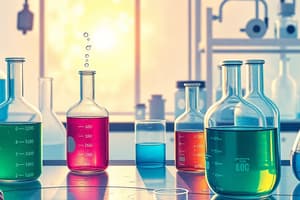Podcast
Questions and Answers
Why is it necessary to add excess potassium iodide (KI) in the titration process?
Why is it necessary to add excess potassium iodide (KI) in the titration process?
- To neutralize the sulfuric acid
- To increase the temperature of the solution
- To act as a catalyst for the reaction.
- To ensure all the potassium permanganate or bleach has reacted and to keep the iodine in solution. (correct)
The first titration is a rough titration and two further titrations should be within 0.5mL of each other for accurate results.
The first titration is a rough titration and two further titrations should be within 0.5mL of each other for accurate results.
False (B)
What is the purpose of placing a white tile underneath the conical flask during a titration?
What is the purpose of placing a white tile underneath the conical flask during a titration?
To see the colour change better.
What is the purpose of putting a pinhole in the tin foil covering the conical flask?
What is the purpose of putting a pinhole in the tin foil covering the conical flask?
When preparing a standard solution of sodium carbonate, it is not necessary to wash all traces of the sodium carbonate into the beaker or volumetric flask.
When preparing a standard solution of sodium carbonate, it is not necessary to wash all traces of the sodium carbonate into the beaker or volumetric flask.
When reading the meniscus in a burette or volumetric flask, the reading should be taken at ______ level.
When reading the meniscus in a burette or volumetric flask, the reading should be taken at ______ level.
Match the observed colour changes in the conical flask during the titration with the correct stage:
Match the observed colour changes in the conical flask during the titration with the correct stage:
What is the standard value for the universal gas constant (R) used in the ideal gas law calculation?
What is the standard value for the universal gas constant (R) used in the ideal gas law calculation?
Why is it important to dilute the bleach solution before titrating?
Why is it important to dilute the bleach solution before titrating?
The formula to calculate the number of moles using the ideal gas law is derived from PV = nRT by dividing by ______
The formula to calculate the number of moles using the ideal gas law is derived from PV = nRT by dividing by ______
Match the step in the procedure for standardizing HCl with the required action:
Match the step in the procedure for standardizing HCl with the required action:
The burette should be rinsed with deionised water only before use.
The burette should be rinsed with deionised water only before use.
What unit is used for volume (V) when using the ideal gas law in these calculations?
What unit is used for volume (V) when using the ideal gas law in these calculations?
How many times should the volumetric flask be inverted to ensure the solution is thoroughly mixed during the dilution of bleach?
How many times should the volumetric flask be inverted to ensure the solution is thoroughly mixed during the dilution of bleach?
In the procedure for preparing a standard solution the volumetric flask should be filled to slightly above the calibration mark for better accuracy.
In the procedure for preparing a standard solution the volumetric flask should be filled to slightly above the calibration mark for better accuracy.
What is used to indicate when the titration is complete when standardising the hydrochloric acid solution with sodium carbonate?
What is used to indicate when the titration is complete when standardising the hydrochloric acid solution with sodium carbonate?
What is the purpose of diluting the vinegar solution in the experiment to determine the concentration of ethanoic acid?
What is the purpose of diluting the vinegar solution in the experiment to determine the concentration of ethanoic acid?
In a titration, it is necessary to read the meniscus from above eye level for accuracy.
In a titration, it is necessary to read the meniscus from above eye level for accuracy.
What indicator is recommended when titrating a strong base with a weak acid?
What indicator is recommended when titrating a strong base with a weak acid?
A ________ is used to accurately measure and transfer a specific volume of liquid, such as sodium hydroxide for titration
A ________ is used to accurately measure and transfer a specific volume of liquid, such as sodium hydroxide for titration
What is placed underneath the conical flask to help see the colour change in a titration?
What is placed underneath the conical flask to help see the colour change in a titration?
The first titration is a precise titration and should be used in calculations.
The first titration is a precise titration and should be used in calculations.
Match the chemical formula with its name:
Match the chemical formula with its name:
Which of these options are correct for experiment to determine the amount of water of crystallisation in hydrated sodium carbonate? (Select all that apply)
Which of these options are correct for experiment to determine the amount of water of crystallisation in hydrated sodium carbonate? (Select all that apply)
What is the purpose of the starch indicator in the titration experiment?
What is the purpose of the starch indicator in the titration experiment?
In the experiment monitoring oxygen production, the rate of production of oxygen remains constant until the hydrogen peroxide is fully decomposed.
In the experiment monitoring oxygen production, the rate of production of oxygen remains constant until the hydrogen peroxide is fully decomposed.
What is the catalyst used in the experiment to monitor the rate of oxygen production from hydrogen peroxide?
What is the catalyst used in the experiment to monitor the rate of oxygen production from hydrogen peroxide?
In the temperature effect experiment, the timer is stopped once the ________ is no longer visible.
In the temperature effect experiment, the timer is stopped once the ________ is no longer visible.
What is the color of the solution after the addition of potassium iodide in the titration experiment?
What is the color of the solution after the addition of potassium iodide in the titration experiment?
In the rate of reaction experiment. the conical flask is placed over a black paper with an X marked on it
In the rate of reaction experiment. the conical flask is placed over a black paper with an X marked on it
In the sodium thiosulfate reaction with hydrochloric acid, what is specifically being measured to determine the rate of reaction?
In the sodium thiosulfate reaction with hydrochloric acid, what is specifically being measured to determine the rate of reaction?
Match the color changes with their corresponding steps in the titration experiment:
Match the color changes with their corresponding steps in the titration experiment:
What is the purpose of adding anhydrous magnesium sulfate to the organic solution in the clove oil extraction process?
What is the purpose of adding anhydrous magnesium sulfate to the organic solution in the clove oil extraction process?
In the soap making process, brine is used to dissolve the soap.
In the soap making process, brine is used to dissolve the soap.
What color change is observed when ethanal reacts with acidified potassium permanganate?
What color change is observed when ethanal reacts with acidified potassium permanganate?
In the soap making process, the _ _ is used as a solvent for the oil.
In the soap making process, the _ _ is used as a solvent for the oil.
What is the key comment for making soap?
What is the key comment for making soap?
Match the following apparatus/substances with their function in the soap making process:
Match the following apparatus/substances with their function in the soap making process:
Why is the soap washed with ice cold water?
Why is the soap washed with ice cold water?
An acidifed potassium permanganate solution acts as an _ agent.
An acidifed potassium permanganate solution acts as an _ agent.
What is the primary purpose of adding sodium carbonate in the oxidation of phenylmethanol to benzoic acid?
What is the primary purpose of adding sodium carbonate in the oxidation of phenylmethanol to benzoic acid?
During recrystallization, using more solvent will result in more crystal formation.
During recrystallization, using more solvent will result in more crystal formation.
What is the chemical name of the compound that produces a fruity smell?
What is the chemical name of the compound that produces a fruity smell?
The brown precipitate formed during the oxidation of phenylmethanol is due to the formation of ______.
The brown precipitate formed during the oxidation of phenylmethanol is due to the formation of ______.
Match the oxidation state of manganese with the corresponding chemical form during the oxidation of phenylmethanol process:
Match the oxidation state of manganese with the corresponding chemical form during the oxidation of phenylmethanol process:
What is the function of hydrochloric acid(HCl) in the oxidation of phenylmethanol?
What is the function of hydrochloric acid(HCl) in the oxidation of phenylmethanol?
The purpose of using a heated funnel during recrystallization is to prevent the benzoic acid from solidifying during filtration.
The purpose of using a heated funnel during recrystallization is to prevent the benzoic acid from solidifying during filtration.
Why is a seed crystal added when recrystallizing benzoic acid?
Why is a seed crystal added when recrystallizing benzoic acid?
Flashcards
Molar Mass Determination of a Volatile Liquid
Molar Mass Determination of a Volatile Liquid
A technique used to determine the molar mass of a volatile liquid by measuring its vapor pressure and volume.
Standard Solution of Sodium Carbonate
Standard Solution of Sodium Carbonate
The standard solution of sodium carbonate is a precisely prepared solution with a known concentration.
Standardization of Hydrochloric Acid
Standardization of Hydrochloric Acid
A solution of sodium carbonate is used to standardize hydrochloric acid by reacting them in titration and determining the exact concentration of the acid.
Titration
Titration
Signup and view all the flashcards
Methyl Orange
Methyl Orange
Signup and view all the flashcards
Indicator
Indicator
Signup and view all the flashcards
Volumetric Flask
Volumetric Flask
Signup and view all the flashcards
Pipette
Pipette
Signup and view all the flashcards
Redox Reaction
Redox Reaction
Signup and view all the flashcards
Reduction
Reduction
Signup and view all the flashcards
Oxidation
Oxidation
Signup and view all the flashcards
Oxidizing Agent
Oxidizing Agent
Signup and view all the flashcards
Reducing Agent
Reducing Agent
Signup and view all the flashcards
Endpoint
Endpoint
Signup and view all the flashcards
Analyte
Analyte
Signup and view all the flashcards
Titrant
Titrant
Signup and view all the flashcards
Standard Solution
Standard Solution
Signup and view all the flashcards
Dilution
Dilution
Signup and view all the flashcards
Deionised Water
Deionised Water
Signup and view all the flashcards
Hydrated Compound
Hydrated Compound
Signup and view all the flashcards
Water of Crystallisation
Water of Crystallisation
Signup and view all the flashcards
Rough Titration
Rough Titration
Signup and view all the flashcards
Accurate Titrations
Accurate Titrations
Signup and view all the flashcards
Decomposition Reaction
Decomposition Reaction
Signup and view all the flashcards
Catalyst
Catalyst
Signup and view all the flashcards
Reaction Rate
Reaction Rate
Signup and view all the flashcards
Effect of Temperature on Reaction Rate
Effect of Temperature on Reaction Rate
Signup and view all the flashcards
Potassium Permanganate (KMnO4)
Potassium Permanganate (KMnO4)
Signup and view all the flashcards
Recrystallization
Recrystallization
Signup and view all the flashcards
Melting Point
Melting Point
Signup and view all the flashcards
Melting Point Determination
Melting Point Determination
Signup and view all the flashcards
Study Notes
Chemistry Experiment Booklet
- Flame Tests: Used to identify metal ions. Each metal produces a unique colour.
- Anions Tests: Used to test for the presence of specific anions (negatively charged ions) in a solution. A common chloride ion test forms a white precipitate with silver nitrate, the precipitate disappears when ammonia is added. A sulphate ion solution forms a white precipitate with barium chloride.
- Molecular Mass of Volatile Liquids: Explores measuring the vapour density to determine the molecular mass of liquid substances.
- Standard Solution of Sodium Carbonate: A known mass of sodium carbonate is dissolved in a precise volume of water, to create a standard solution.
- Standardizing Hydrochloric Acid: Standard sodium carbonate solution is used to determine the concentration of a hydrochloric acid solution.
- Sodium Hydroxide Solution: A known mass of sodium hydroxide is measured and dissolved in a volumetric flask, and then standardized with hydrochloric acid.
- Concentration of Ethanoic Acid in Vinegar: A precise volume of vinegar is diluted and titrated with a standard base solution (e.g., sodium hydroxide) using an indicator.
- Water of Crystallisation in Hydrated Sodium Carbonate: Analysed to determine the amount of water in hydrated salt crystals.
- Iron in Iron Tablets: A known mass of iron tablets is dissolved and titrated with potassium permanganate to determine the iron content.
- Percentage of Sodium Hypochlorite: A measurement of sodium hypochlorite in household bleach using sodium thiosulfate in a titration.
- Reaction Rate (Temperature): Sodium thiosulfate's reaction rate with hydrochloric acid is monitored at different temperatures to determine how the change in temperature affects the reaction rate.
- Reaction Rate (Concentration): Sodium thiosulfate's reaction rate with hydrochloric acid is monitored at different concentrations to determine how changing concentration affects the reaction rate.
- Le Chatelier's Principle: Iron III chloride and potassium thiocyanate are used to demonstrate the principle, by showing how changes in temperature or concentration affect a system at chemical equilibrium.
- Total Water Hardness: Water samples are measured using EDTA to determine the total hardness of water.
- Total Suspended and Dissolved Solids: The presence of suspended and dissolved solids is measured using filter paper weight and evaporation techniques.
- Dissolved Oxygen: A redox titration method is used to analyze the dissolved oxygen content of water by determining the amount of iodine released from a specific reaction.
- Free Chlorine in Swimming Pools: Various chlorine standards are made and measured using a colorimeter to estimate the free chlorine concentration in a swimming pool.
- Preparation of Ethylene and Examined Properties: Ethylene is prepared and tested for its physical (colorless sweet smelling gas) and chemical properties (reaction with bromine, combustion).
- Preparation of Ethyne and Examined Properties: Ethyne is generated and tested for its characteristics, including its physical attributes (colourless, sweet smelling gas) and chemical qualities (combustion and reactions with other substances).
- Heat of Reaction with Hydrochloric Acid and Sodium Hydroxide: Reaction heat is measured in a polystyrene cup to calculate heat of neutralization.
- Clove Oil Extraction: Steam distillation extracts clove oil from cloves, separating it from water.
- Preparation of Soap: The reaction between oils and sodium hydroxide is used to synthesize soap, which is then filtered and dried.
- Reactions of Ethanal: The oxidation reactions of Ethanal with potassium permanganate (acidified), Fehling's reagent, and ammoniacal silver nitrate (silver mirror test) are explored, confirming if the reactants are aldehydes or ketones, and the conditions impacting the results.
- Ethanioc Acid with Sodium Carbonate: Ethanoic acid reacts with sodium carbonate, producing carbon dioxide gas which is detected using limewater.
- Ethanoic Acid with Magnesium Metal:, A reaction between ethanoic acid and magnesium metal is explored, producing hydrogen gas, observable through a "pop" test.
- Ethanoic Acid with Ethanol: Ethanol and ethanoic acid react in the presence of a catalyst (sulfuric acid) to form an ester (ethyl ethanoate) evidenced by the fruity smell of the product.
- Oxidation of Phenylmethanol: The reaction of phenylmethanol with potassium permanganate under alkaline conditions and subsequent crystallization are examined.
- Recrystallization of Benzoic Acid: To purify benzoic acid, through recrystallization using a vacuum filtering setup.
- Boiling Point of Benzoic Acid: The melting point of benzoic acid is tested and reported.
- Separation of Ink Components: Paper chromatography method is used to separate the ink's components into its different dyes.
Studying That Suits You
Use AI to generate personalized quizzes and flashcards to suit your learning preferences.




